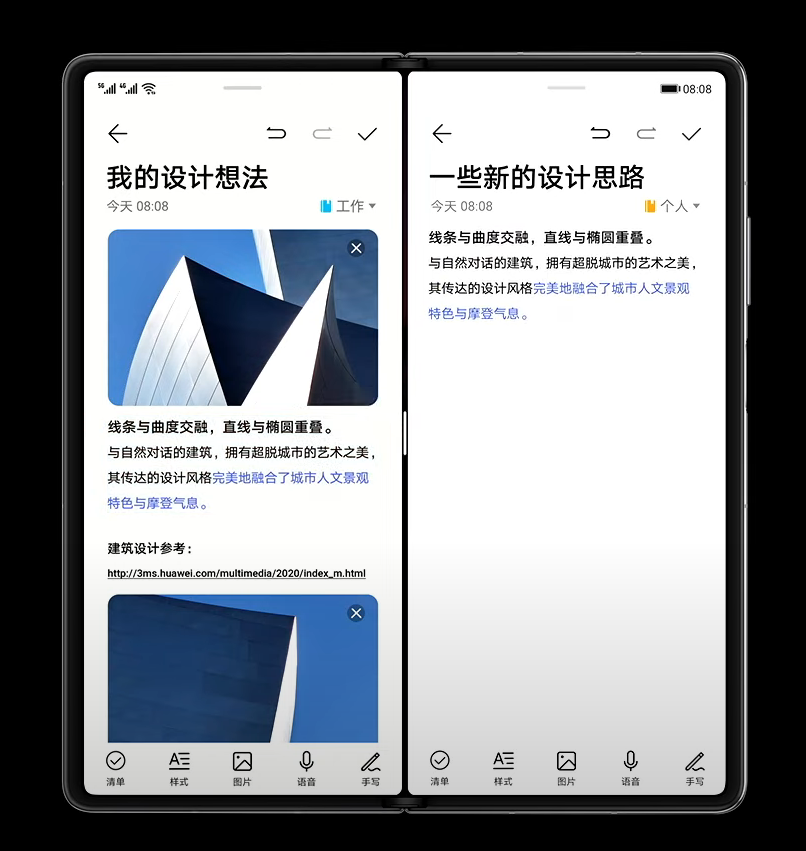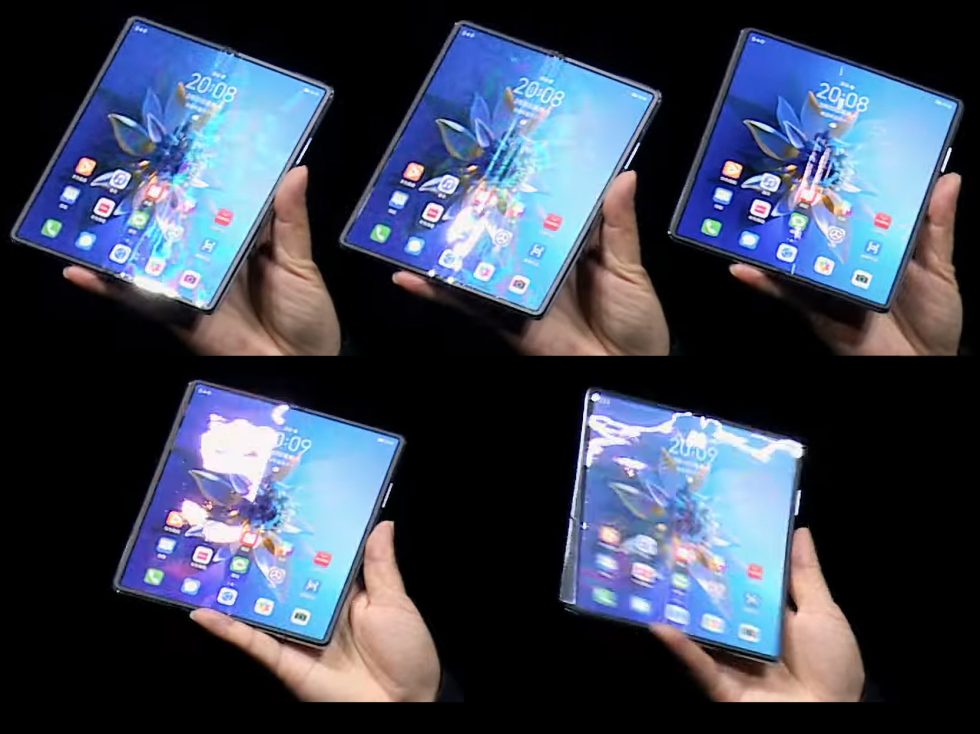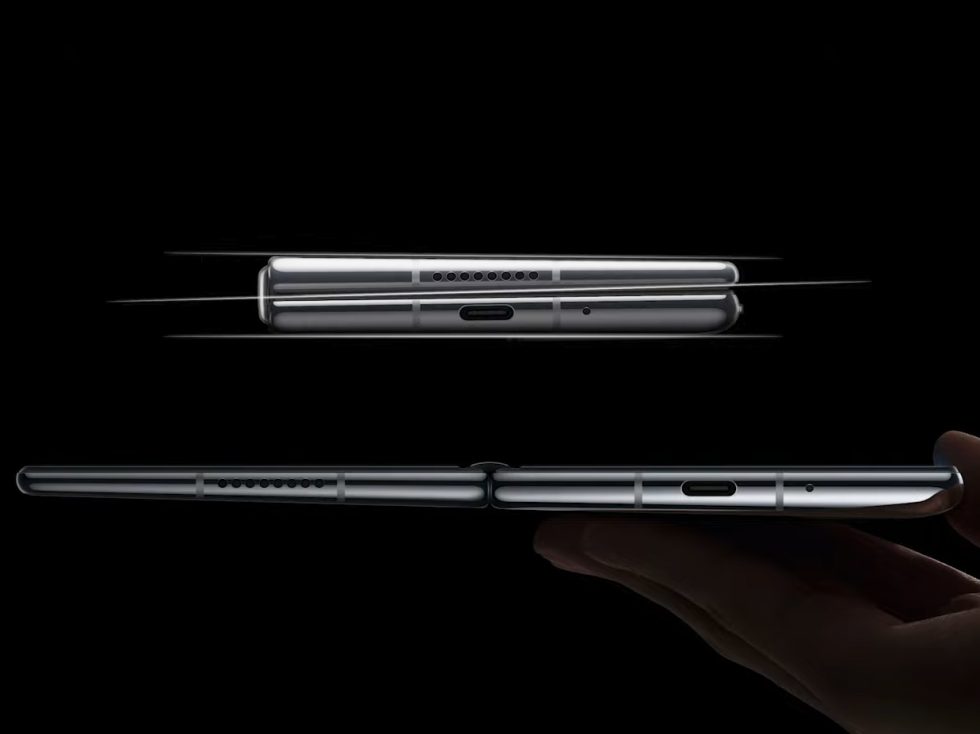 The Huawei Mate X2. It looks just like a Galaxy Z Fold 2.
The Huawei Mate X2. It looks just like a Galaxy Z Fold 2. Huawei did a great job on the bezels and aspect ratio. That's a normal 21:9 display on the front, and the interior screen is nearly two 21:9 displays put together, which will be great for split screen.Huawei
Huawei did a great job on the bezels and aspect ratio. That's a normal 21:9 display on the front, and the interior screen is nearly two 21:9 displays put together, which will be great for split screen.Huawei A live picture of the front. If you squint, this almost looks like a normal smartphone.Huawei
A live picture of the front. If you squint, this almost looks like a normal smartphone.Huawei A live picture of the inside.Huawei
A live picture of the inside.Huawei Split screen looks great. Those are two normal-sized windows.Huawei
Split screen looks great. Those are two normal-sized windows.Huawei A closeup of the front camera. Notice that is looks like a dual-camera cutout, but there's actually only one camera.Huawei
A closeup of the front camera. Notice that is looks like a dual-camera cutout, but there's actually only one camera.Huawei Just like a Moto Razr, some of the display backing swings out of the way when closed, allowing the display to form a teardrop shape and not be creased.Huawei
Just like a Moto Razr, some of the display backing swings out of the way when closed, allowing the display to form a teardrop shape and not be creased.Huawei The hinge mechanics use a bunch of tiny gears.Huawei
The hinge mechanics use a bunch of tiny gears.Huawei It folds flat.Huawei
It folds flat.Huawei The back colors.Huawei
The back colors.Huawei Huawei put some special work into the keyboard, which is totally resizable and features duplicate center keys so you can still hit them with either finger.Huawei
Huawei put some special work into the keyboard, which is totally resizable and features duplicate center keys so you can still hit them with either finger.Huawei
Huawei isn't going to let a minor inconvenience like US sanctions stop it from designing new phones. Today, the company announced the next device in its flagship foldable-smartphone line: the Huawei Mate X2. While 2019's Mate X (X1?) was an innovative-but-impractical form factor with a single wraparound display on the outside of the phone, the Mate X2 follows Samsung's lead and goes with a book-style foldable with a rigid phone screen on the outside and a foldable tablet screen on the inside. It looks just like a Galaxy X Fold 2 but with a few interesting design evolutions.
Huawei spent a lot of time saying the Mate X2 was better than the Samsung Galaxy Fold 2, pointing out bigger interior and exterior screens as well as a smaller hinge area with slimmer bezels on the front. One thing Huawei didn't compare is the price, which starts at a whopping $2,784, while the Galaxy Fold 2 is $2,000.
The exterior screen is a 6.45-inch, 2700×1160, 90Hz OLED, while the interior screen is an 8-inch, 2480×2200, 90Hz OLED. Both are bigger than those in the Fold 2, which has a 6.2-inch outside display and a 7.6-inch inside display. Huawei's work to slim down bezels looks impressive, and it really feels like the company got the aspect ratios right. Huawei managed to fit a bog-standard 21:9 display on the front—it looks like a normal smartphone from some angles. The interior display is nearly two 21:9 display put together, with what Huawei called a "8:7.1 aspect ratio." It's hard to say what the interior aspect ratio "should" be, since Android tablet apps are nearly nonexistent, but at least this will be good for split-screen app usage.

The folding action of the Mate X2 looks like a cross between Samsung's Fold 2 and the Moto Razr. From the Fold, we have internal, behind-the-screen gears for the hinge action. From the Razr, we have a hinge that results in a teardrop display fold when closed, instead of a hard crease. Just like in the Razr, there are two foldaway support plates to the left and right of the hinge. They swing out of the way when the device closes up, allowing the phone to close without crushing the display. Huawei says the device closes without a gap.
One big downside to this being a Huawei device and not a Samsung device is that it won't have Samsung's ultrathin glass display cover. Samsung is currently the only company shipping a foldable display cover that is even slightly rigid to the touch, while everyone else is using a crinkly, ripply, plastic display cover that moves around anytime you touch it.During the presentation with a live unit, a light reflection briefly rolled across the display, highlighting just how uneven the display surface is. Like on the Moto Razr, there is no support overtop of the hinge area, so the flexible display sags over top of the hinge and forms a considerable trench running down the middle of the display. The light also emphasized all sorts of uneven ripples and distortions along what should be the "flat" sides of the display.

One interesting design choice: the body of the Mate X2 is a wedge shape. When open, the right side of the phone is 8.2mm, which tapers down to the left side measurement of 4.4mm. Huawei says the right side of the phone is thicker so it can house all the cameras in a normal phone body, which is roughly 8mm thick. The left side of the phone doesn't need as many components, so it can be thinned out as much as possible.
I'm not one to push for ever-thinner smartphones with slimmer batteries and the removal of headphone jacks, but for foldables, thickness is a major concern if you want to actually carry one in a pocket. Plenty of these early devices are as thick as two smartphones stacked on top of each other, and that just doesn't fit well in a pocket. Huawei's tapered design and fold-flat hinge really looks like a winner here. The company is turning in a device with the same size battery as the Galaxy Z Fold 2, 4500mAh, but has shaved nearly 2mm off the 16.8mm thickness, turning in a 14.7mm-thick device when folded up.
But is it even possible for Huawei to build this phone in any significant quantities? Huawei is still in the midst of a suffocating US export ban, which has made the company unable to source parts from international suppliers and has sent its market share plummeting. Huawei Consumer Business Group CEO Richard Yu kicked off the Mate X2 presentation with a few defiant words for the US government. "2020 was an extraordinary and challenging year for Huawei," Yu said. "We found ourselves simultaneously attacked by the COVID-19 pandemic and the second and third rounds of US sanctions, which has posed great difficulties to our business operation and day-to-day work. However, thanks to the solid support of our partners, suppliers, and in particular, consumers around the globe, we survived 2020!"
Surviving 2020 is one thing, but Huawei's market share is still rapidly trending downward, and things only look more bleak heading into the future. There are already reports that Huawei's smartphone output will be cut in half in 2021. Here's just one of what are probably many supply problems: the Mate X2 has a Huawei HiSilicon Kirin 9000 SoC, built on TSMC's 5nm process, but TSMC halted shipments to Huawei in September 2020. According to supply chain reports, Huawei ordered 15 million chips produced, but TSMC was only able to deliver just over half that, 8.8 million chips, before the cutoff deadline. This supply needs to be stretched across the Mate X2, the flagship slab smartphone Mate 40 Pro, and probably one more launch this year, the P50 Pro.Keep in mind that the Mate X2 also won't have any Google apps. Speaking of Huawei's software issues, the company ended the show with the announcement that "Huawei flagship-phone users" will be able to upgrade their phones to Huawei's in-house OS, HarmonyOS, starting in April, and the Mate X2 will be one of the first to do it. So according to Huawei, the phone will ship with Android and be upgraded to HarmonyOS. For those who missed our earlier report, Huawei claims that HarmonyOS is its in-house operating system, but after actually looking at it, there is no discernible difference between HarmonyOS and Android. It should be an easy "upgrade," at least.
With all the supply issues and the barely there launch of the Mate X in 2019, it's hard to treat this like a real phone, but Huawei claims it will be for sale, in China only, on February 25.
Listing image by Huawei
Article From & Read More ( Huawei’s new $2,800 foldable phone copies Samsung’s Galaxy Fold line - Ars Technica )https://ift.tt/3bnJJQ0
Tecnology
Bagikan Berita Ini















0 Response to "Huawei’s new $2,800 foldable phone copies Samsung’s Galaxy Fold line - Ars Technica"
Post a Comment